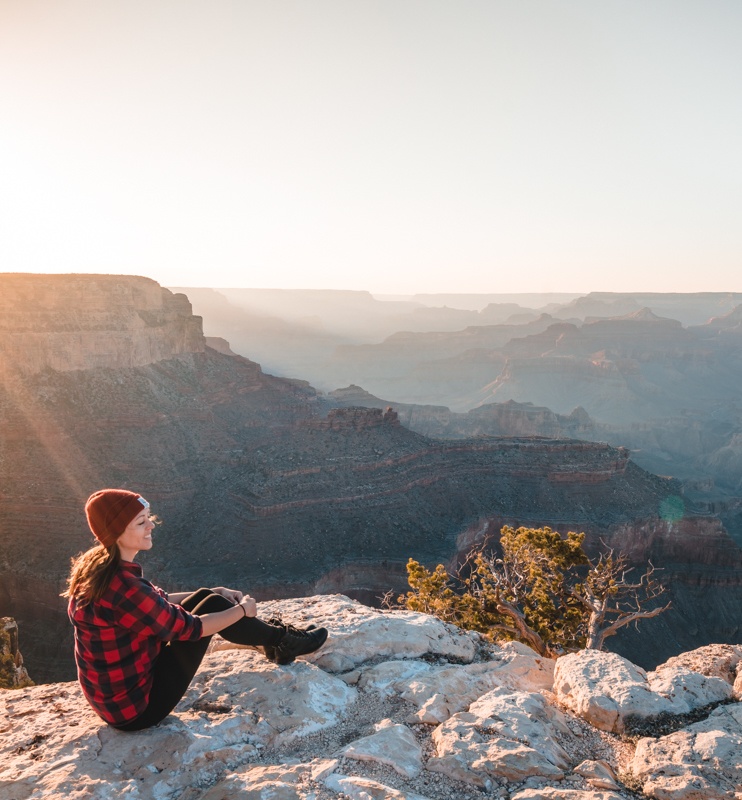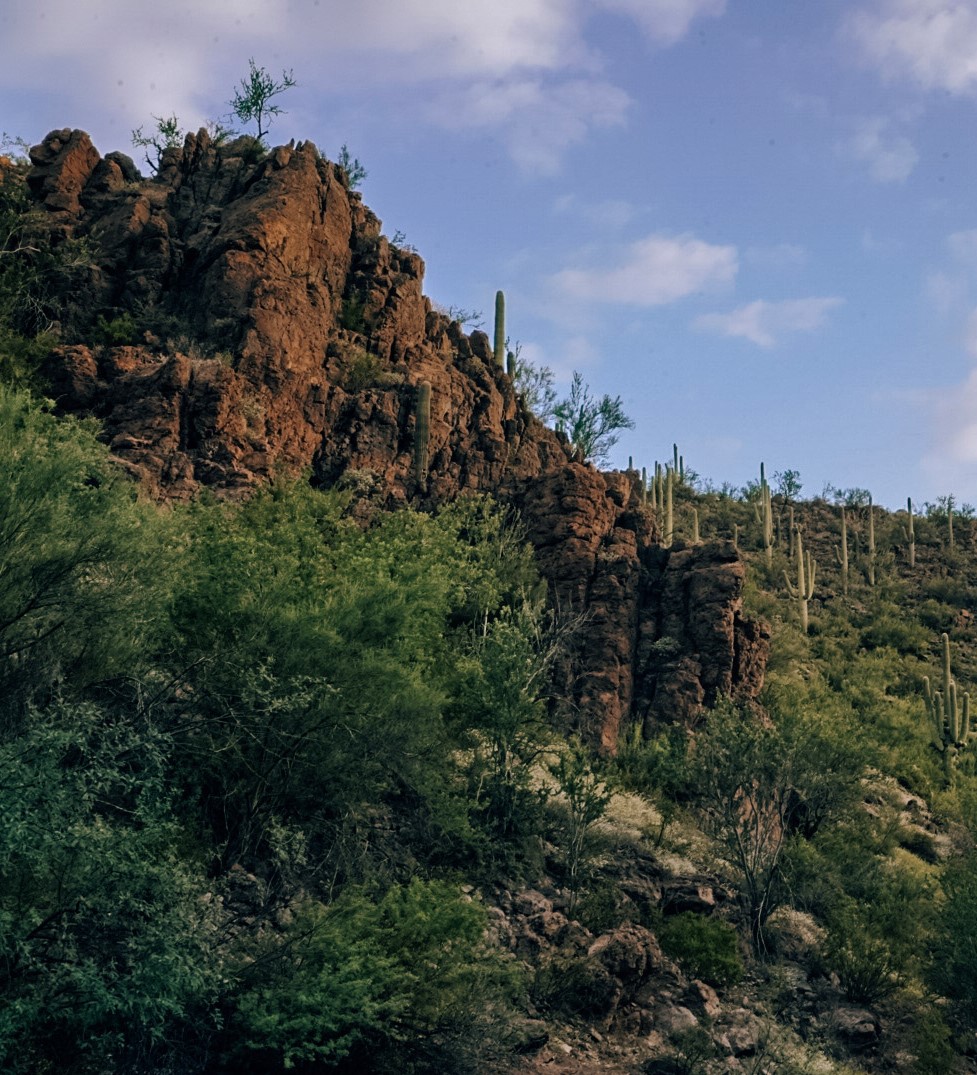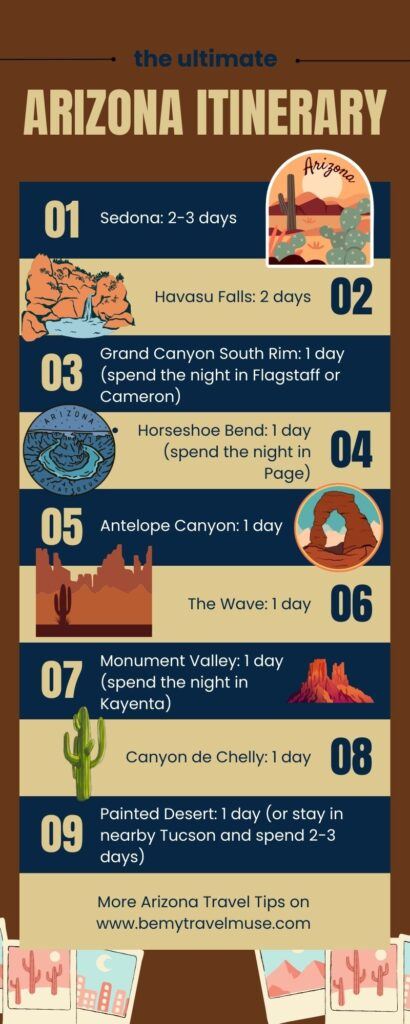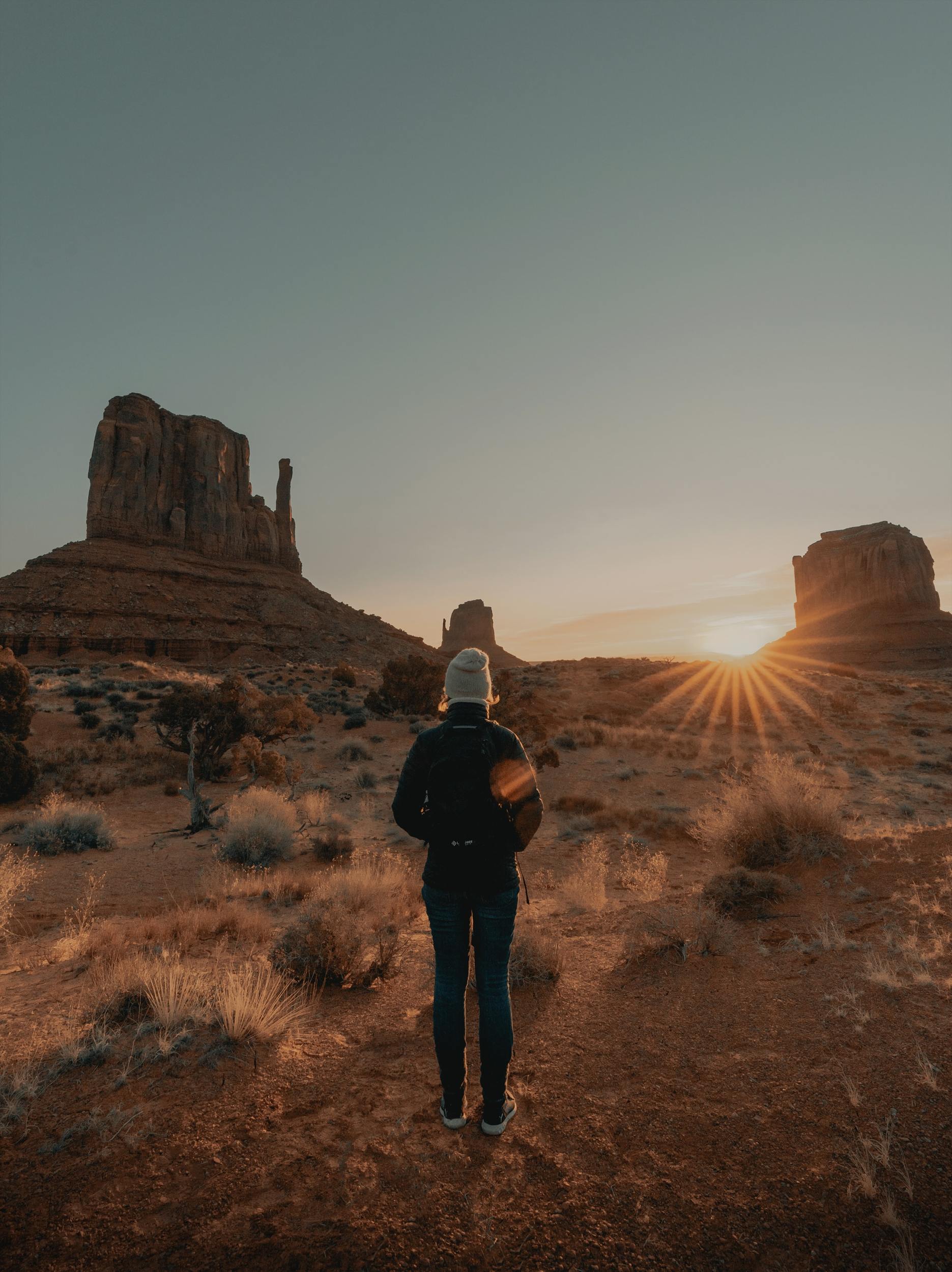Arizona is an outdoor-lover’s dream, with deep canyons, dramatic landscape and a whole host of adventures where the land formations are the star of the show.
Exploring Arizona, is all about appreciating the wide-open spaces and the way the sky lights it up throughout the day.
Incorporating some of Arizona’s most incredible things to see, some of which are mega-famous and some of which are lesser known, this is my ideal Arizona itinerary:
Where You’ll Go:
- Sedona: 2-3 days
- Havasu Falls: 2 days (hiking there is a full day, but you can also camp along the way)
- Grand Canyon South Rim: 1 day (spend the night in Flagstaff or Cameron)
- Horseshoe Bend: 1 day (spend the night in Page)
- Antelope Canyon(s): 1 day (spend the night in Page again)
- The Wave: 1 day
- White Pocket: 1 day (can visit on the same day as The Wave)
- Monument Valley: 1 day (spend the night in Kayenta)
- Canyon de Chelly: 1 day
- Painted Desert: 1 day (or stay in nearby Tucson and spend 2-3 days)
Day 1-3: Sedona

This itinerary begins in Sedona after leaving Phoenix Sky Harbor International Airport. From Pheonix to Sedona, the drive will be a little over 2 hours. Sedona is an artist’s town surrounded by beautiful rock formations, with multiple hikes in the area worth checking out. Some of the more famous and beautiful ones include the Devil’s Bridge, Bell Rock and Cathedral Rock. They’re all pretty short, moderate hikes with a big payoff at the end.
I just hiked in and around Sedona with Felix and I can wholeheartedly recommend visiting with a family.
Depending on how long you have to devote to your Arizona trip, it may make sense to base yourself here for a couple of days to chill out and enjoy the vibe while doing some of the nice, short hikes in the area. You can see what my solo trip there was like here:
I’ve also visited solo, and these were my favorite things to do in Sedona.
Then, you’ll drive 2:45-3 hours to Havasu Falls.
Day 4-5: Havasu Falls

Those famous baby blue falls truly are that color in real life! If you manage to score a permit for Havasu Falls, prepare to be amazed.
To be able to access the falls, you’ll need to hike in for 10 miles, armed with all of the gear that you’ll need for your time there. Permits go on sale once per year in February, though there may be cancellations throughout the year, which would give you a chance to nab some last-minute permits. It takes a lot of work to get there, but it’s worth it! You can read more about all of the important things to know about Havasu Falls here.
If you cannot get a permit for Havasu Falls, I still recommend visiting the Hopi region. This culture and archaeology tour is a wonderful alternative!
This is a great place to rest your head after visiting Havasu Falls.
After the hike, you’ll drive another 2:45 hours to the Grand Canyon South Rim.
Day 6: Grand Canyon South Rim

I can’t believe I’m saying this, but ‘Grand’ somehow seemed like an understatement while looking at the Grand Canyon. It truly is the biggest, most vast canyon I’ve ever laid eyes on, carved by the mighty Colorado River. Visiting an overlook is epic, but seeing it from a helicopter is a next-level experience.
The South Rim will be the most geographically proximate to Sedona for this itinerary, and it tends to be more breathtaking as well, with several stunning overlooks all along Desert View Drive. I headed there in the afternoon, which gave me plenty of time to stop at most of the overlooks on my way to the sunset at Yavapai Point. I highly recommend stopping at the less popular, lesser-known overlooks on your way; they are often even more spectacular than their more popular counterparts! My favorite was Lipan Point.
Flagstaff can be a good place to spend the night, though you will have to backtrack a bit. Alternatively, you can spend the night in Cameron. Though the hotels are not as abundant with only a few options such as the Cameron Trading Post and their RV Park, it will save you some time if you’re on a tight schedule.
Stay in a sky dome after visiting the South Rim.
From here, you’ll drive about 2:30 hours to Horseshoe Bend.
Day 7: Horseshoe Bend
Heading north towards Page is where you can see some of Arizona’s most famous spots. Surely, you’ve seen photos of Horseshoe Bend with its pleasing symmetry. This is one of my favorite spots for sunset photos in the area.
This one is pretty easy to get to, with a parking lot right near the overlook. It’s only about a 10-minute walk from the parking lot to the overlook itself. There are no railings, so be careful on the edges and get there early if you want a good spot for sunset photography.
If you’re short on time, you can knock out Horseshoe Bend and the following location, Antelope Canyon, in the same day on this tour from Flagstaff.
This is a cute stay near Horseshoe Bend.
Then, Antelope Canyon is just a 15-minute drive away.
Day 8: Antelope Canyon
Arguably the most famous slot canyon in the world, Antelope Canyon truly is mesmerizing. This one is located on Navajo land and in order to access these slot canyons, you’ll need to join a tour. During popular times of year (May through September), it’s imperative to book ahead of time if you want to be in there for prime-time light beams. For my fellow photographers, that’s usually at some point during midday, and you’ll probably notice that these tours are priced a bit higher.
There are actually two Antelope Canyons: Upper and Lower. Upper is more famous and also can be narrower, and Lower is a bit wider, though there are stairs to access it. For a full comparison of Upper versus Lower plus links for booking you can read my blog post here. I recommend this tour, which includes the entry ticket and a guide.
Stay here another night.
From Page, drive about 1:30 hours to reach The Wave Trail.
Day 9: The Wave & White Pocket
Like Havasu Falls, The Wave is incredible to see in person from what I hear, though I’ve never had the pleasure; the permitting process is so competitive. There are two ways to get permits for The Wave. You can show up in Kanab, Utah, the day before you wish to go, or you can try your luck with the online system four months before you wish to go. Permits are reserved half-and-half between the two. The only downside is you have to pay for the permit application online whether you get approved or not.
From what I hear, it’s totally worth the hype and I hope that one day I get to check it out. Since I was unable to get permits, I went to the next place on this list instead and was totally blown away.
From The Wave Trail, drive 1:15 hours to White Pocket.
White Pocket is totally different than The Wave, but it’s not too much farther away and you might just get lucky and be the only one there. You’ll see wave-like rock formations and white rocks that look like turtle shells. Perhaps what’s more amazing is the way the sun moves throughout the day, completely changing the colors and the way the rocks look. The jury is out on how this was actually formed, with several different theories, but one thing is for sure: There’s nothing else quite like it in the world.
Part of the reason why this one is less popular is because you have to drive through deep sand to get there, so it is best to take a tour with a local guide. Read my recommendations for visiting white pocket here. If you want to visit the White Pocket only, skipping The Wave, check out this guided tour.
Stay here for the night.
Get ready for the longest drive of the trip so far! From White Pocket, you’ll drive 4:30 hours to Monument Valley.
Day 10: Monument Valley
When you venture into Monument Valley, which shares a border with Southern Utah and is located near Mexican Hat, it’ll be obvious how the area got its name. The rock formations seem to appear out of nowhere and indeed, many are hat-shaped.
Monument Valley is located on a Navajo reservation, as are many of the suggestions on this list. To get in, you’ll need to pay an entrance fee and take a tour, which you can join by showing up. Or you can do this sunset tour with a Navajo guide, which looks awesome! Give this a few hours so that you can fully enjoy Monument Valley’s formations.
This is a great place to stay after visiting Monument Valley.
Then, you’ll drive about 1:30 hours to Canyon de Chelly.
Day 11: Canyon de Chelly
A worthy detour from Monument Valley to Page, Canyon de Chelly (pronounced like ‘Shay’) receives far fewer visitors and was nearly devoid of other tourists when I visited in February. It’s a national monument that is also located on a reservation, and in order to hike into most of it you will need a local guide. However, the Spider Rock Overlook, which is the park’s most famous attribute, is accessible without a guide.
If you have the time and it’s not the middle of summer, which would be too hot, there are multi-day guided hikes throughout the canyon which must be quite a unique experience that not many people do. You can find out more here.
From there, drive 1:15 hours to the Painted Desert.
Day 12: Painted Desert
Finally, on your way back to Phoenix, why not check out Petrified Forest National Park and the Painted Desert for fossils, badlands, buttes, ancient petroglyphs, and at some points of year, wildflowers!
Much of this park can be seen from overlooks, although there are some back-country trails that at cooler times of year could be worth checking out. Check out the National Park Service for more information on planning your visit.
If you’re sticking around in Tucson, this is a stellar place to stay. Here’s a great spot in Phoenix, too.
From the Painted Desert, you can drive about 4 hours back to Phoenix, or take a detour and drive 5 hours to Tucson.
All of the roads on this itinerary are well-maintained and the map below will help you navigate:
As you can see, there’s a lot of driving time involved (check car rental prices here!), however it’s mostly on roads without much traffic and through stunning landscape where the clouds turn orange as they reflect the ground below.
Bonus: Spend Days 13-14 in Tucson

If you want to extend your trip a couple of days to make it a full two weeks, Tucson is the ideal spot to round it out. This historical and cultural city is an incredible place to get some much-needed R&R before you head home, and there’s plenty to do if you’re still looking for adventure.
Tucson is just an hour from Phoenix, so you can easily finish your trip there.
What to Pack
Packing up for a 2-week (or longer!) road trip surely isn’t the same as packing for a “regular” vacation. There’s a lot to consider, and you can find an epic road trip checklist here. You can also find a full backpacking packing list here, which will serve you well on this outdoorsy trip!

Though those are my personal highlights, Arizona is a huge state full of national forests and even more national monuments and deserts. The good news is it’s all amazing and you can’t really go wrong.
I recommend renting your car with Alamo Rent A Car, whom I partnered with to bring you this awesome itinerary. You can see more Arizona suggestions on Alamo’s The Scenic Route guide where I wrote for their blog as well!
Enjoy exploring one of the most incredible American Southwest states!
Read More:
The Perfect American Southwest Road Trip
Upper vs. Lower Antelope Canyon – Which is Better?
14 Things to Know about the Havasu Falls Hike

*This post was brought to you in partnership with Alamo Rent A Car, however all thoughts of Arizona’s best places are entirely my own. Your trust always comes first!







Tuliyani MacLennan says
I had no idea there were so many beautiful places to see in Arizona! I’m hoping to do a road trip myself, but I’ll have a limited amount of time. Thanks for these tips!
Kristin says
have fun!
Keelie Cox says
Arizona is on my list! So many beautiful places, thanks for the great read!
Heba says
Me too!
Myrna Z says
We are coming back for another family summer vacation in Arizona the first two weeks of July. We have been to the Grand Canyon and Horseshoe Bend before as well as the city of Jerome. Wanted to visit Antelope Canyon as we missed out on this place during our last visit which was two years ago. With a month left for planning, and keeping in mind that we are interested in visiting Antelope Canyon, The Wave and White Pocket, do you think we still have time to get permits? Or will it be easier to just join a day tour to visit these places? What do you suggest? Appreciate the help.
Kristin says
I’d book Antelope canyon now to get the times you want, and the wave is tricky because you just have to show up and hope for the best, or try to get permits online which might be worth it. White Pocket doesn’t require a permit so it’s a good backup.
Anonymous says
Looks awesome! I’m looking to go this October. Were there plenty of places to stop for gas along the way? Or did that part of your road trip require a little more effort in planning?
Kristin says
I generally didn’t have issues. Just don’t wait until the last minute to fill up.
Fraser Laveay says
Amazing list of places! I definitely need to get to the wave and a couple others. Beautiful pictures too!
sarah treglown says
Hi! I’m planning a trip tp AZ with my daughter for her college graduation and this was so helpful. Do you recommend a private vehicle pass and individual pass or does the vehicle pass allow for the both of us to get in? Any info is helpful. This is our first time to Grand Canyon. Thanks!
Kristin says
Do you mean in terms of national parks? One parks pass is enough for both of you 🙂
Narendra says
Hello, Thanks so much for a great post. Two of us are planning a trip there From Nov 1 to 13, 2021. Is that a good time
to go? Would you happen to know if the spot are open due to Covid restrictions? DO you have any suggestions of an
itinerary to cover all of these spot?
Thanks so much in advance.
Kristin says
I believe the Navajo nation is still closed. I’d also check snow and weather before heading to the higher elevations. Have fun!
Stan Seeberg says
One of the most wonderful places on planet Earth is in Arizona. It is known as Meteor Crater and is near Winslow. Over billions of years the Earth and other planets in the solar system have been pelted with a huge number of cosmic objects including meteorites and asteroids. If you look at the moon through a telescope, there are craters there but here on Earth the vast majority are gone due to weathering and erosion. Many of the craters on Earth that have been discovered are in some cases many miles in diameter and often visible only from the air and cannot be visited. The best preserved impact crater is known by several names including Canyon Diablo and Barringer Crater. There are videos online but they can only hint at this magnificent crater which is nearly a mile across and several hundred feet deep. You can go into the visitor center which has marvelous displays including the largest meteorite found weighing over 1,400 pounds and it is displayed in the open where people can actually touch this “visitor from outer space”. Weather permitting you can walk along a section of the crater’s rim and a staff member will explain what you are seeing and how the crater was formed. Here is my short description: about 50,ooo years ago a nickel-iron meteorite about 150 feet in diameter struck the ground. The impact was so great that solid rocks were turned into something resembling face powder and most of the incoming object was destroyed with pieces of meteorite thrown for several miles from the impact. You are in for an experience that you will never forget! The admission price is low compared with that of entering many amusement parks. There is nothing like it in the world. Travel there and enjoy it!